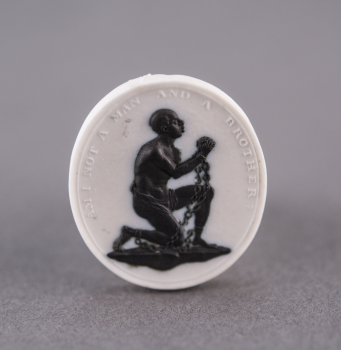W&L’s Museums Talk Female Abolitionists The public discussion, which explored female abolitionists’ roles in history, featured Lena Hill, dean of the college; Ron Fuchs, senior curator of ceramics; and Nneka Dennie, assistant professor of history.
The Museums at Washington and Lee University hosted a virtual conversation, “Making History: Women, Ceramics, and Abolition,” on March 3.
The Reeves Center exhibit “Breaking the Chains: Ceramics and the Abolition Movement” inspired the talk. While “Breaking the Chains” was the first official exhibition of abolitionist ceramics at the university, the Reeves collection has displayed many abolitionist pieces for years. It now has one of the most extensive collections of ceramics in existence from the abolitionist period, which began in 1810 and lasted until the abolishment of slavery in the United States in 1865.
The virtual event hosted 75 attendees for the discussion, which featured Lena Hill, dean of the college; Ron Fuchs, senior curator of ceramics; and Nneka Dennie, assistant professor of history. The three explored female abolitionists’ roles in history and examined the various forms of activism during the abolition movement, anti-slavery ceramics and the tension between agency and exploitation.
Hill moderated the discussion, and Dennie and Fuchs examined the history from two different perspectives.
Dennie spoke about Black women’s lives and what they looked like in slavery and in freedom. She spoke about Mum Bett, an enslaved woman who was the first person to sue for her freedom successfully. Dennie also discussed Maria Stewart, the first woman to lecture publicly before interracial and co-ed audiences, and Mary Ann Shadd Cary, an abolitionist and suffragist who was also the first Black woman newspaper editor in North America.
“Although there were many Black women who were also central to the fight against slavery, due to their race and gender, they’re often pushed to the peripheries of our historical memory,” Dennie said.
Fuchs focused on White women’s involvement in the abolitionist movement with a direct tie to ceramics. Some fascinating pieces in the collection include the medallions made at Josiah Wedgwood’s Etruria Factory in Staffordshire, England, between 1787 and 1800. The small image on the medallion depicts a slave kneeling in chains and imploring, “am I not a man and a brother?” This scene was the first, most common and most effective anti-slavery image created by the abolitionist movement.
“These images were designed to provoke white viewers to think about the horrors of slavery and what they should do to end it,” said Fuchs.
 Made at Josiah Wedgwood’s Etruria Factory, Staffordshire, England, 1787-1800. One of the most famous images of the abolition movement, the kneeling slave was designed in 1787 for the Society for Effecting the Abolition of the Slave Trade.
Made at Josiah Wedgwood’s Etruria Factory, Staffordshire, England, 1787-1800. One of the most famous images of the abolition movement, the kneeling slave was designed in 1787 for the Society for Effecting the Abolition of the Slave Trade.
You must be logged in to post a comment.